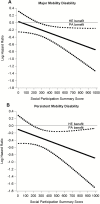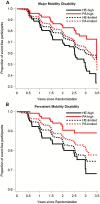Social Participation Modifies the Effect of a Structured Physical Activity Program on Major Mobility Disability Among Older Adults: Results From the LIFE Study
- PMID: 28482106
- PMCID: PMC6178963
- DOI: 10.1093/geronb/gbx051
Social Participation Modifies the Effect of a Structured Physical Activity Program on Major Mobility Disability Among Older Adults: Results From the LIFE Study
Abstract
Objectives: To investigate whether baseline social participation modifies the effect of a long-term structured physical activity (PA) program on major mobility disability (MMD).
Methods: 1,635 sedentary adults (70-89 years) with physical limitations were randomized to either a structured PA or health education (HE) intervention. Social participation was defined categorically at baseline. High social participation was defined as attending organized group functions at least once per week and visiting with noncohabitating friends and family ≥7 hr per week. Anything less was considered limited social participation. Participants performed a standardized walking test at baseline and every 6 months for up to 42 months. MMD was defined as the loss in the ability to walk 400 m.
Results: There was a significant intervention by social participation interaction (p = .003). Among individuals with high levels of social participation, those randomized to PA had significantly lower incidence of MMD (hazard ratio [HR], 0.43 [95% confidence interval (CI), 0.27-0.68]; p < .01) than those randomized to HE. Individuals with limited social participation showed no mobility benefit of the PA intervention when compared with their HE counterparts (HR, 0.92 [95% CI, 0.77-1.11]; p = .40).
Discussion: Our findings suggest that baseline social participation is an important factor for the success of a PA intervention aimed at delaying mobility disability.
Figures


References
-
- Avlund K. Lund R. Holstein B. E., & Due P (2004). Social relations as determinant of onset of disability in aging. Archives of Gerontology and Geriatrics, 38, 85–99. doi:10.1016/j.archger.2003.08.003 - PubMed
-
- Borg G. (1988). Perceived exertion and pain scales. Champaign, IL: Human Kinetics.
-
- Burke S. M. Carron A. V. Eys M. A. Ntoumanis N., & Estabrooks P. A (2006). Group versus individual approach? A meta-analysis of the effectiveness of interventions to promote physical activity. Sport and Exercise Psychology Review, 2, 19–35.
Publication types
MeSH terms
Grants and funding
LinkOut - more resources
Full Text Sources
Other Literature Sources
Medical

